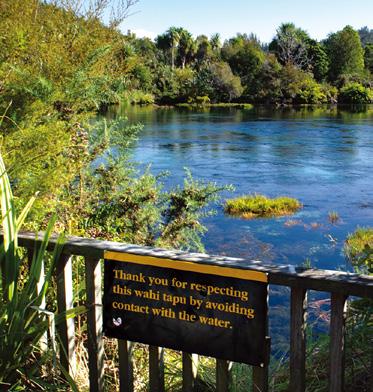
2 minute read
Farming, Tourism and Ownership Timeline
1850s - Miners cleared the forest area around the springs to mine gold. Water taken from the springs was diverted along a pipeline and sluiced to look for gold. Large boulders were washed and stacked to one side.
1850s - The land around the springs was claimed by the Crown and then sold into private ownership for farming and after changing hands several times.
Advertisement
1890 - much of the original lowland forest cover of the Waikoropupū Valley had fallen to the goldminers axe or the farmers fire, luckily a remnant of forest was spared. Forest cover is slowly regenerating over the 26-hectare Te Waikoropupū Scenic Reserve and associated protected lands.
Early 1900s - A viewing platform was built after an increase in tourists.
1901–1908 - Hydraulic methods of gold mining were used in the Te Waikoropupū Valley by the profitable Tākaka Hydraulic Sluicing Company.
1912s - The land around the Springs was purchased by the Tākaka Sluicing Company’s manager, Charles Campbell and his daughter Hilda later inherited the land.
1929 - The Hydraulic Sluicing Company water race, over one kilometre in length, was recommissioned to serve as a power station.
1950’s onward - Diving was a drawcard for many who came from all over the world to experience the unique, aquatic environment and clear waters of Te Waikoropupū Springs.
1979 - Hilda Campbell recognised the importance of the Springs and sold 9 acres to the Crown on condition that they were preserved and managed for the New Zealand public.
1984 - a lower jetty-style platform was built with a periscopic box to assist underwater viewing. The box not highly successful so was removed in 2012.
2007 - The Department of Conservation closed off access to the Springs to to prevent the introduction of the invasive alga Didymo (Didymosphenia geminata) and other aquatic pests. This is the first time in this country’s history that people have been prohibited from touching a public body of water.
2007 - The waters of Te Waikoropupū were closed to the public.
2010 – Name changed to Te Waikoropupū Springs Scenic Reserve. Pronunciation and spelling of Waikoropupū varied over the years, including Waiaramoomoo, Waikoromumu, Waikaremumu, Bu Bu, and for the Pupū Springs Scenic Reserve.

2013 – Ngāti Tama ki Te Waipounamu Trust and Andrew Yuill submit an application for a Water Conservation Order to the Minister for the Environment to protect the waters of Te Waikoropupū and its associated water bodies.
It is only through iwi objections spanning 20 years that Te Waikoropupū Springs is not commercialised today. Ngāti Tama have objected to all commercialisation, namely glassed bottomed boats, gold mining, bottling water for human consumption and commercial diving trips.
It is because of our responsibility as kaitiaki (guardians) that iwi nurture and protect this breath taking wāhi tapu (sacred) environment, we call Te Waikoropupū. It is paramount for future generations that Ngāti Tama continue to preserve this taonga (treasure) in its unique pristine state.








